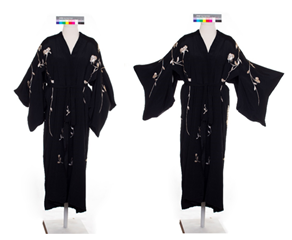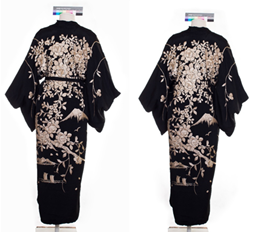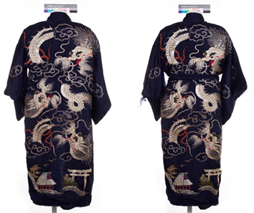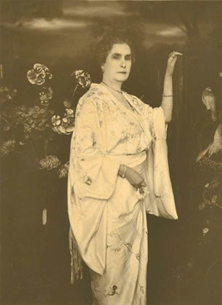Journal of
eISSN: 2574-8114


Mini Review Volume 9 Issue 2
1PhD student in Museology and Heritage by the Postgraduate Program in Museology and Heritage, Federal University of the State of Rio de Janeiro (PPGPMUS - UNIRIO/MAST), Brazil
2Master’s degree in Museology and Heritage by the Postgraduate Program in Museology and Heritage, Federal University of the State of Rio de Janeiro (PPGPMUS - UNIRIO/MAST), Brazil
3Master’s degree in Preservation of Science and Technology Collections by the Graduate Program in Preservation of Science and Technology Collections (PPACT-MAST), Brazil
Correspondence: Gabriela Lúcio de Sousa, PhD student in Museology and Heritage by the Postgraduate Program in Museology and Heritage, Federal University of the State of Rio de Janeiro (PPGPMUS - UNIRIO/MAST), Brazil
Received: April 14, 2023 | Published: April 27, 2023
Citation: de Sousa GL, Faria AGP, Ferreira MP. Breaking with the hegemonic: Maria Augusta Rui Barbosa through her kimonos at the Rui Barbosa Historic House Museum. J Textile Eng Fashion Technol. 2023;9(2):54-57. DOI: 10.15406/jteft.2023.09.00333
Since mid-2016, the Rui Barbosa Historic House Museum (MCRB) has been systematically carrying out - through research grants and independent studies in graduate programs - studies on Maria Augusta Rui Barbosa, wife of Rui Barbosa, through its collection present at the institution. This paper will present some results of these studies.
Keywords: Maria Augusta Rui Barbosa, trajectory, kimonos, museum collections, gender studies
The Rui Barbosa Historic House Museum (MCRB) is a division of the Rui Barbosa Foundation (FCRB), a Brazilian federal institution belonging to the Ministry of Tourism. The MCRB is recognized as a historic house museum, an institution dedicated to guarding customs and objects related to the family habits of the former residents, in this case the Rui Barbosa family, thus preserving the place as it was, as a residence in use, respecting the building-characters-objects triad. For this purpose, in addition to the composition of the exhibition, the museum has 1550 objects of different types.
Among these items, two pieces of clothing were highlighted for studies, between the years 2016 and 2018, through a research grant in the Scientific Scholarship Program (PIC), called Maria Augusta Rui Barbosa kimono’s: research, conservation and access to public. The proposal had as objectives, from theoretical-practical investigations, to understand the kimonos of Maria Augusta Rui Barbosa in its entirety, that is, covering since the life of Maria Augusta, before and after becoming Rui Barbosa's wife; the study of their kimonos as artifacts and part of the museum collection; using primary sources, secondary sources and interviews; textile preservation methodologies; scientific analysis and management of the climatic condition of the guard site and its surroundings; a new proposal of expography that preserves materiality and allows appreciation and communication to the public.1
In this short article, an excerpt referring to the user of kimonos: Maria Augusta Rui Barbosa, in addition to her husband, will be discussed. Her existence as a woman, not only as Rui Barbosa's wife, as is customarily presented, demystifying the thinking about this character, and producing a counter-hegemonic path to society's patriarchal thinking. Through the research of her kimonos, it was possible to decolonize the thought about her, with this, the biography of the object allowed reflections on the character's biography. To compose the research sources together with the objects, files from the Institutional Historical Archive Service (SAHI) were used, referring to Maria Augusta Rui Barbosa, the testimonies of the 'Rui's Memory Project', as well as articles from newspapers, magazines and interviews with family members, acquaintances, and workers of the institution, aiming to make the figure of this woman autonomous.
The parallel: knowing the Maria Augusta Rui Barbosa’s kimonos
Maria Augusta's two kimonos have a cataloging number and catalog card. The number 66.881A (Figure 1) (Figure 2) is described as a “kimono in black silk, short sleeves and a belt to tie around the waist. Decorated by branches, leaves, flowers, mountains and boats embroidered in white thread”. (PIRES 1998, 2). The 50.810A (Figure 3) (Figure 4) is presented as a “kimono in navy blue silk, embroidered in shades of white, red, green, ocher and light blue. Short sleeves and sash to tie around the waist. Decorated by dragons, clouds, trees and kiosks”. (PIRES 1998, 2).

Figure 1 Black kimono number 66.881A (Front and back), 2017. Rui Barbosa Historic House Museum. Photograph by Gabriel Garcia Silva, Rui Barbosa Historic House Museum.

Figure 2 Black kimono number 66.881A (Front and back), 2017. Rui Barbosa Historic House Museum. Photograph by Gabriel Garcia Silva, Rui Barbosa Historic House Museum. .

Figure 3 Black kimono number 66.881A (Front and back), 2017. Rui Barbosa Historic House Museum. Photograph by Gabriel Garcia Silva, Rui Barbosa Historic House Museum.

Figure 4 Black kimono number 66.881A (Front and back), 2017. Rui Barbosa Historic House Museum. Photograph by Gabriel Garcia Silva, Rui Barbosa Historic House Museum..
According to an interview conducted in August 1960, Maria Adélia Rui Barbosa Batista Pereira (Delita), the couple's granddaughter, Delita, affirms that the kimonos were gifts from her son, João Barbosa, to Maria Augusta. At the time he purchased the pieces, the boy was probably 20 years old, and would have bought them on a trip to Japan (PIRES 1998, 2). The two pieces have no labels and no other record of use by Maria Augusta. It is known that she was interested in this clothing model due to a photograph present in the institution's iconographic collection, where she wore a similar model in white (Figure 5).

Figure 5 Maria Augusta wearing a white kimono, which does not belong to the MCRB collection, 2016. Rui Barbosa Historic House Museum. Image by Iconography site, Rui Barbosa Historic House Museum.
Maria Augusta Rui Barbosa: what we known
Maria Augusta Rui Barbosa was born Maria Augusta Viana Bandeira. She was the daughter of Alfredo Ferreira Bandeira and Maria Luísa Viana. She was married for 46 years, and had five children Maria Adélia Rui Barbosa (Dedélia), Alfredo Rui Barbosa, Francisca Rui Barbosa, João Rui Barbosa and Maria Luísa Vitória Barbosa (Baby). She passed away at 93, living more than twenty years without her husband. Even, Baby, the couple's youngest daughter, reports her father's overwhelming passion for his mother, stating that he could not live without his wife. Maria Augusta, however, would find the strength to continue without Rui Barbosa, leaving evident a certain independence.
Maria Augusta, before the wedding, did not have relevant financial funds since her father was a public agent. However, her family was part of the Bahia aristocracy, and the distinction of her origin was fundamental to the social development of the Rui Barbosa family:
Without her aristocratic education and her recognized performance as a lady and host of "high society", Rui would not have been able to sustain a salon and even a respectable worldly life for the rigid demands of her circles. It should be remembered here that “Cota” (as he called it intimately) since young was recognized in Bahia for its elegance, maintained despite the notorious economic decay of her old and aristocratic family, the Viana Bandeira.2
"She was considered a beautiful, attractive, slim figure, taller than Rui Barbosa and with the appearance of a great lady".3 Hers physical attributes are mentioned in several publications, however, a little about personality.
According to Viana Filho, biographer of Rui Barbosa, Maria Augusta was a proud, independent and willing woman. This attitude can be seen in the choice of her husband. Salustiano Ferreira Souto, doctor and family friend, “was the one who introduced Rui and his friend Rodolfo Epifânio de Sousa Dantas to Maria Augusta. On the eve of the presentation, she had said that she would marry one of them”.3
New possibilities: the set of mourning objects
It was the fact that the kimonos were incorporated at such different dates - 1950 and 1966 - that led us to the dress. After the death of Maria Augusta Rui Barbosa, on April 27, 1948, the period between 1949 and 1958 was especially rich in the incorporation of museum items related to the widow, but not to her grief.
Only in 1966 did the family offer the Casa de Rui Barbosa Museum a set of objects (Figure 6) that they still kept with them, including the delicate cambric handkerchief 66,883A that covered the face of her dead husband, the black silk dress 66,880A, the black hand fan 66,889A, black kimono 66,881A, mesh shirt 66,879A with which Rui died, his 66,887A scissors for pruning roses and the 66,877A flag used in the transfer of her husband's mortal remains to Salvador, in 1949.

Figure 6 Set of objects related to Maria Augusta Rui Barbosa's grief, 2021. Image by Iconography site, Rui Barbosa Historic House Museum..
The construction of this exhibition narrative about the mourning of Maria Augusta Rui Barbosa will also enable the expansion of public access possibilities to the black hand fan and to another flow of navigation that will be access to the gifs of the other Maria Augusta hand fans that, for reasons Conservatives, they cannot be handled, opened, closed and shaken, except at the time of production of this method of capture and stop motion animation, which was applied to the collection's kimonos.
Stop motion creates the illusion of motion of what is standing still because it displays at a higher or lower speed the sequence of photographs of the same object in slightly different positions, delicately modified. Each of these photographs is treated as a frame or frame and all must be captured from exactly the same vantage point. This type of animation comes from the early days of cinematography, when the passage of more than 12 frames per second caused the illusion in the human brain that something was moving: it is the physical phenomenon of Retinal Persistence (Persistence of Vision).
The iconographic documentation keeps images of the matriarch's presence on relevant occasions in the political scenario in which her husband was inserted - such as having accompanied Rui's entourage to the Peace Conference (Haia 1907), the visit of the president of Portugal Antônio José de Almeida to his residence (1922), or even his constancy in the electoral campaign for the presidency of the Republic of Rui Barbosa (1909-1910) -, even more private scenes - such as the walk in the garden beside Rui (1918) or his portrait using a deshabillé inside his house - and also public social occasions - such as posthumous tributes to the patron at “Casa Rui Barbosa” (1940s) -, among others.
In the study of clothing between the 19th and 20th centuries, the prominence of the essentiality and prominent place of the hat and the fan as fashion accessories that complement clothing, with use that goes beyond the functional sphere of head covering and flap, is a common ground. The head coverings that had at the same time the functionality of protection from excessive heat and the rigors of winter, became indispensable to the clothing of the period. The fan that had the act of fanning itself as a functionality arrived in Brazil, as a fashion, with the life of the Portuguese royal family and its use included a codified language linked to seduction.
Maria Augusta: decolonizing her figure
Even with marked importance, especially for the FCRB, little has been studied about Maria Augusta Rui Barbosa. Such an issue is noted given the lack of material about Maria Augusta herself, either written by her or about her. Usually referred to as “great Brazilian lady”,4 “great woman of a great man”,4 and “a strong woman who through over the years, she was an appeaser for her husband's difficult genius and a quiet manager of a harmonious home.”.5
It is known that she was an outstanding figure in the context of creating the MCRB as a museological institution. After Rui Barbosa's death, the matriarch of the family decided to jointly sell the house, the library and her husband's intellectual production to the State. Such a sale was much less profitable, since the State offered the minimum value for the set, in addition, other buyers were interested in the separate purchase. However, in order to maintain and perpetuate the memory of his family, the sale to the Brazilian government was made:
Maria Augusta's initiative was decisive in making it a public good. When deciding as an inventor to make a catalog of the entire collection and only sell it in an integrated manner, he took the last and definitive step towards preservation, allowing its use with a new meaning of citizenship.6
She "had a definite participation in the preservation of Rui Barbosa's memory, by ignoring other more advantageous proposals for the purchase of the house and library in favor of the Brazilian Government".7 According to reports, the maintenance of this memory was so relevant to Maria Augusta that she lived in a much less luxurious financial situation than she could, without ever complaining about this situation.
Endowed with strong decisions and material detachments, such as the one previously reported, Maria Augusta donated her wedding ring to the "Gold for the São Paulo's good" campaign, which took place during the Constitutionalist Revolution of 1932. When questioned and criticized for her attitude, she said that, if your husband was alive, he would agree.8 Here, a behavior common to women is established, which is still present today: the validation of their actions through male approval. The decisions taken by Maria Augusta, guided or not by her husband, are preponderant and must be recognized as such.
During the investigation, it was clear that, as among individuals, a large part of the collective singularization is achieved by reference to the passage of time,9 the entire research process carried out - which the matter ended but presented results and possibilities - they reaffirm the singularization of these clothes, which could be mundane, but due to time, place and character, they perpetuate memory. Also, the “singularization of objects within a society creates a special problem. As it is done by groups, it carries a certificate of collective approval, channels the individual impulses of singularization and assumes the weight of cultural sacredness”,9 sacralization is not thought as a result, but rather, a (re) knowledge of something and someone. Things, in this case kimonos, as objects of reminiscence, were enjoyed, also thinking about the reconstitution of the memory of its user, Maria Augusta Rui Barbosa, a well-known figure, but little studied.
As already mentioned, no material written by Maria Augusta herself has been found so far, and what we know about her is the result of reports from family and close people. Thus, the conclusions and questions we have about the character are based on testimonials from third parties. Maria Augusta's own words are lacking in this context, but, through these reports, it is already possible and not only that, but also certain observations and statements about the user could be rethought. Maria Augusta Rui Barbosa is considered here in addition to Rui Barbosa. For several moments, she was called in this research only as Maria Augusta, her baptismal name was rescued, and we played her part in her own history, with the advent of research difficulties, which still persist. There is still more to be told, and more women to be unveiled.
Olga Obry, writer for the “Feminine Silhouette” column of the Night’s Journal, wrote a note about Maria Augusta in her publication in the newspaper in 1951, emphasizing the limited amount of information about Maria Augusta in a biography of the period, written by Michel Simon. Obry also commented, through Simon's words, that Maria Augusta liked poetry and music, thus revealing literate interests, and concludes her article by saying that “one day someone will look over documents or documents, to bring to light the day the female silhouette, which remains shrouded in shadow”.10 We followed the research seeking to meet such a noble demand.
Authors declare that there is no conflict of interest exists.

©2023 de, et al. This is an open access article distributed under the terms of the, which permits unrestricted use, distribution, and build upon your work non-commercially.